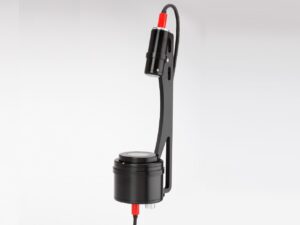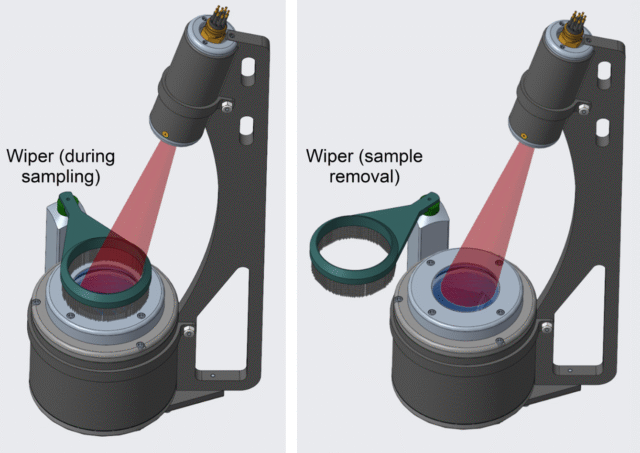In the Beginning…
In the 1960’s oceanographers started suggesting that sinking particles were a main source of food and nutrient delivery to deep-sea organisms. Researchers soon conceived and deployed sediment traps to investigate further (Wiebe et al., 1976). They quickly realized that the sediment trap design and the ambient current flow influenced trapping efficiency (Hargrave & Burns 1979). Much effort went into theoretical and experimental studies on sediment trap designs, including various shapes (cylindrical, conical), baffled, brine-filled etc. (Butman 1986). Excellent reviews and overviews are given by Gardner (1980), Buesseler et al. (2007) and Baker et al. (2020).
Researchers can deploy sediment traps in a stationary configuration (Eulerian), such as on a bottom lander or integrated into a mooring string. Alternatively, they can deploy the traps in a freely drifting configuration (Lagrangian), allowing them to drift with the current at a predetermined depth. Comparisons between moored and drifting traps show no difference in trapping efficiency for current velocities < ~15 cm s-1. As velocities increase beyond ~15 cm s-1, moored traps under-trap by 75-90 % compared to the drifting traps (Buesseler et al, 2007).
A Maybe Surprising Realization
Researchers have now realized that particles do not settle directly into stationary sediment traps (i.e., Eulerian). Rather, the internal flow-field within the trap governs particle retention: The weak horizontal oceanic flow across the sediment trap generates an eddy in its upper section. This eddy entrains water and particles advected horizontally into the trap, where they interact with slower eddies deeper within the trap. These particles are finally transferred to the trap bottom through settling, as the eddies interact with the trap’s boundary layer (Buesseler et al, 2007).
Trap shape (e.g., cylindrical or conical), design features (such as baffles), and internal density gradients (e.g., the use of brines) influence the trapping efficiency of sediment traps. Three dimensionless parameters guide the trapping efficiency:
- the trap Reynolds number Rt = uf * D * ν-1
- the ratio uf/W and
- the trap aspect ratio A = H/D.
uf: Horizontal current velocity; D: trap diameter; ν: fluid kinematic viscosity; W: Particle settling velocity; H: trap height.
Other things being equal, trapping efficiency decrease with increasing Rt and uf /W, and increase with increasing A. Researchers have found that achieving good collection efficiency in cylindrical sediment traps requires aspect ratio (A) values greater than three, and ideally greater than five (cf. references above) for stationary traps. Note that the trap aspect ratio does not matter if the trap is drifting, i.e. on a Lagrangian platform.
Developments Since the 2000’s
Classical sediment traps have some shortcomings:
- they generally do not provide real-time or near real-time data.
- users must retrieve the traps to collect and process the samples.
- the deployment duration and sample capacity limit the temporal resolution and total flux that can be measured.
- they cannot integrate on autonomous profiling floats, e.g. Argo floats.
For this reason, concerted efforts since the mid-2000’s have tested various types of Optical Sediment Trap designs to provide proxy measurements specific to the POC flux under steady-state conditions. See references in Estapa et al. (2024). Solutions have typically revolved around upward-looking camera systems or beam transmissometers. Estapa et al. (2024) identified several shortcomings of these methods. Sequoia, in collaboration with Dr. Meg Estapa at University of Maine specifically designed the LISST-OST (Optical Sediment Trap) to address these shortcomings.
LISST-OST: The New Kid on the Block
Sequoia introduced the LISST-OST in 2024, and it differs significantly from existing commercially available sediment traps from, e.g. McLane Labs:
- It is designed as per the recommendations in Estapa et al. (2024).
- It has no tube or cone, so it retains no sample.
- It is purely an optical sensor with no aspect ratio.
- Sequoia’s engineers designed the system for multi-year deployments on autonomous platforms, specifically BGC-Argo floats.
- It is self-cleaning / self-zeroing when deployed on floats (i.e., Lagrangian mode).
- It may have some applications for stationary deployments (i.e., Eulerian mode), e.g. if the user designs and adds a trapping tube.
An overview of the LISST-OST is given by Simon et al. (2024) and Simon et al. (2025). For now, simply notice that the LISST-OST essentially is a modified transmissometer with an off-axis optical geometry and a much larger diameter of illumination – almost 5 cm Ø at the receive window – compared with traditional beam transmissometers. See figure.
- LISST-OST dimensions. Note top view, showing collecting window unobstructed by instrument housing.
- LISST-OST.
This design enables the sensor to collect sinking particles while minimizing the disruption of their natural settling pathways and simultaneously measure the diffuse attenuation. (Diffuse, because the LISST-OST employs a spreading, uncollimated beam, not to be confused with ‘diffuse attenuation’ referring to the decrease in light with depth).Footnote 1
This principle works well in a Lagrangian mode with no or very minimized flow across the optical window (e.g., Bishop et al., 2004; Terrats et al., 2023; Estapa et al., 2024): Particles will rain down and accumulate on the LISST-OST optical window when the float is at parking depth, then wash off as the float ascends to make a profile and transmit data collected since last surfacing. Users process and QC the time history of diffuse attenuance following Estapa (2023) to yield diffuse attenuance flux. With minimal effort, the relationships between the beam attenuance flux and POC flux, established by Estapa et al. 2024, can be transferred to correlate POC flux to the LISST-OST diffuse attenuance flux.
The situation changes when users want to deploy the LISST-OST in a stationary mode (i.e., Eulerian):
- Sensor tilt will cause particles to slide off.
- Currents across the optical window will wash off particles.
- Because there is no actual trap, particles are unlikely to accumulate in proportion to the ambient settling flux.
- Accumulating particles will eventually block the beam.
For this reason, Sequoia has designed a wiper with a brush for window cleaning and a cup for particle collection. See figure.
The wiper has an aspect ratio of 0.63, which is not optimal for sediment trap design (cf. review and references above). However, it cannot be taller as it will then interfere with the oblique beam. In Eulerian mode, users must expect to have to establish their own relationships between settling flux and the LISST-OST diffuse attenuance. These are likely to be highly variable and site-specific.
1Do not confuse the diffuse attenuation from the LISST-OST with the diffuse attenuation for various K functions referring to a decrease in light with depth, e.g., Kd. It is not the same. LISST-OST does not measure Kd. Back to reference


